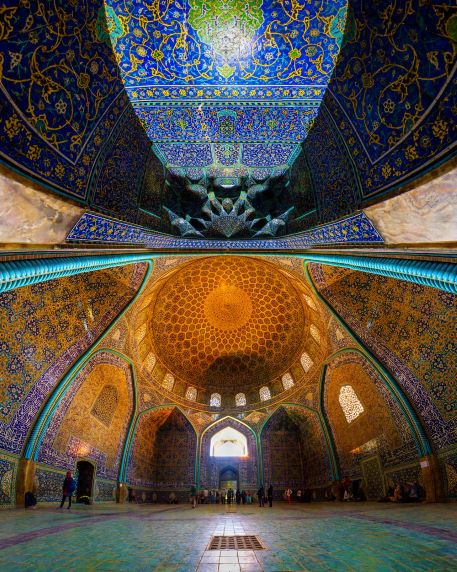
- Naqsh-e Jahan Square – The Heart of Isfahan
- Naqsh-e Jahan - The history behind the name
- Naqsh-e Jahan - Isfahan historical background
- Stages of Naqsh-e Jahan construction
- Significance for the city and the state
- Structural elements of the square
- The architecture of Naqsh-e Jahan Square
- Cultural significance
Naqsh-e Jahan Square – The Heart of Isfahan
Naqsh-e Jahan Square is the second-largest square in the world that is listed as a UNESCO World Heritage Site.
history Throughout, the name of the square has changed: before the Islamic Revolution, it was known as Shah Square, and after 1979, its official name became Imam Square, in honor of the leader of the revolution, Ayatollah Ruhollah Khomeini. However, both Iranians and foreign travelers more commonly refer to it by another name – Naqsh-e Jahan. To begin with, it is important to explain what this name means.
Naqsh-e Jahan - The history behind the name
Naqsh-e Jahan, which means "image of the world" or "picture of the world" in Persian, has a rich history that is closely intertwined with the Safavid dynasty, which ruled Iran during the 16th–18th centuries. At the peak of the Safavid Empire's power, during the reign of Abbas the Great (1588–1629), it was announced that the capital would be moved from Qazvin, located in the northern part of the country, to a new location in Isfahan, in the south. At that time, the city acquired the second name, "Half of the World". The reason for this is that Isfahan contains so many beautiful and impressive sights that its greatness could only be appreciated after travelling around half of the world. The square of the new capital, Naqsh-e Jahan (trans: "Image of the World Square"), impressed travellers with its splendor and unique architecture.
Naqsh-e Jahan - Isfahan historical background
When Abbas the Great declared Isfahan the new capital of the state in 1590, the process of relocating the capital from Qazvin took approximately six years. During this time, a group of remarkable architects and artists came together to shape the city’s architecture. They faced a challenging task: redesigning the city and reconstructing the main structures originally built during the Seljuk era (11th century). The goal was to transform Isfahan and completely redefine the concept of an Iranian city that was to serve as the capital of a great power. The transition involved replacing the cramped, walled city with its winding streets and dense buildings with one characterised by wide avenues and open public spaces. However, this transformation needed to preserve the essence of Isfahan’s historical identity, shaped over centuries, without causing significant harm.
This grand project took several decades to complete, and the initial changes affected the main attraction of Isfahan — the old square (Meydan Kohne), where the bazaar was located. The old square did not align with Shah 'Abbas’s vision for the main square of the Safavid capital, whose population at the time, according to the notes of the French traveller Jean Chardin, approached half a million people. It was necessary to create a public space that would attract the city’s residents and travellers, as well as symbolise the power of the state. Therefore, at the turn of the 16th and 17th centuries, the construction of Naqsh-e Jahan Square began.
Stages of Naqsh-e Jahan сonstruction
In 1590-1591, the square began to take the form of a public space. First of all, Safavid builders levelled the surface of what would become Naqsh-e Jahan, shaping it into a rectangle. The square was also surrounded with a row of arches, which was initially one story high. Additionally, majestic gates (Ali Qapu) were constructed on the western side of the square to separate the public area from the Safavid residence and royal gardens.
Another important structure was the bazaar, which was located on the northern side of Naqsh-e Jahan Square. The bazaar was initially built to meet the needs of the residents of the palace complex (the mansions of the Safavid elite) and their visitors. That is why it was often referred to as the royal bazaar (Qeysarie bazaar). The construction of the new bazaar and the expansion of its trading space played a significant role in the establishment of economic links between Isfahan's old commercial center and Naqsh-e Jahan. From that time on, Naqsh-e Jahan became a significant location for people who were engaged in trade and craft.
In 1602, construction work on the square resumed in full force. At that time, the plan was to make Naqsh-e Jahan more functional for both buyers and those involved in trade and craft: for example, an additional row of commercial premises was added and the second floor was constructed. Naturally, this meant that the area of the square would become smaller, but from an economic perspective, it promised great benefits. From that point on, the entire complex consisted of a long covered arcade with many shops on both sides of the walkway, including commercial and craft spaces on the second floor.
At the beginning of the 17th century, two unique structures of the Safavid era were constructed - the Sheikh Lotfollah Mosque and the Shah Mosque (Masjid-e Shah, also known as the Imam Mosque). Therefore, by the first half of the 17th century, these two buildings became part of the square's ensemble, which has been preserved until today.
Significance for the сity and the state
Naqsh-e Jahan Square fulfilled a number of significant functions for the state. First of all, as mentioned earlier, it became the economic centre of the entire state. Naqsh-e Jahan also served as a venue for various religious ceremonies and official government events. Military parades and festive celebrations with fireworks were held in the square, as well as various competitions and sports games. For example, the famous chovgan game (Chogān-bāzī) - an ancient Iranian version of polo. Today, the square is paved with stone, but in the 17th century, its surface was covered with sand specifically for this game. The chovgan game on Naqsh-e Jahan Square has often been depicted in Iranian miniature art. It is surprising that the gates for the chovgan game can still be found along the edges of the square today.
Structural elements of the square
The square is a large rectangular space with measurements 160 by 560 metres. The entire area of Naqsh-e Jahan covers approximately 9 hectares. The square is surrounded by two-storey arcades, which form a covered bazaar complex. In the middle of the square, there is a parking lot for visitors, along with a pool and fountains.
Undoubtedly, the buildings located on each of the four sides of the square draw the attention of every traveller. On the western side stands the Ali Qapu Palace, built at the very end of the 16th century as a residence for Shah 'Abbas I. On the northern side, you can find the Qeysarriyeh Bazaar, which represents the economic might of the state. To the east of the square, there is an entrance to the Sheikh Lotfollah Mosque, which became a symbol of Shia Islam, the official religion of the Safavid dynasty. Finally, the Shah Mosque dominates the southern side of the square and, according to one interpretation, represents the strength of the Islamic community.

The architecture of Naqsh-e Jahan Square
Thus, all the elements of the square, including the structures located on its sides, were built at the same historical era and have the same style, forming a cohesive ensemble called Naqsh-e Jahan. These structures complement each other both architecturally and and symbolically. For this reason, it is important to examine all the details of these remarkable buildings.
Let’s begin with the Ali Qapu Palace. The name can be translated as "High Gate" or "Great Gate", which reflects the purpose of the structure: the palace was originally designed as a front entrance, leading to the palace complex, which included garden with pavilions.
This five-storied building with an open portico is the residence of the monarch, overlooking Naqsh-e Jahan Square. It was built in the first half of the 17th century by order of Shah 'Abbas I. Ali Qapu Palace is where the emperor received noble guests and foreign ambassadors. It is also the place where Nowruz, the Iranian new year, is celebrated in spring.
The palace is artistically unique, with its walls that were covered in murals by the court painter of Shah 'Abbas l, the famous master Reza Abbasi (1565-1635), and his students. The murals in Ali Qapu feature characteristic floral and animalistic motifs.
Moving from the Shah’s palace to the northern side of the square, we can see the Grand Bazaar, also known as the Qeysarriyeh Bazaar. This is only one part of Isfahan's vast bazaar complex, which is connected with the other bazaars and caravanserais via long covered passages and numerous alleys. One can easily get lost in the maze-like alleys of the Isfahan bazaar, especially as their eyes are drawn to the beauty and diversity of the goods created by Iranian artisans and artists.
All these various passages serve as important communication routes for the movement of people and goods. Previously, goods were transported by camels, donkeys, and mules. Now, they arrive by lorries and, after storage, are distributed to various workshops.
We continue on and find ourselves at the entrance to the Sheikh Lotfollah Mosque, whose dome stands out clearly from the portico of the Ali Qapu Palace. This mosque was built by the chief architect, Mohammad Reza Isfahani, exclusively for members of the ruling dynasty. It was inaccessible to the general public, which is why its design does not include minarets. Construction began in 1602/1603 and ended in 1618/1619. This small, intimate mosque symbolizes not only the commitment to Shia Islam but also the personal piety of the Shah and court. The mosque is named after Sheikh Lotfollah, a renowned theologian from Lebanon who was invited by the Safavid dynasty to teach the fundamentals of Shia Islam in Iran.
A brief architectural tour of the square ends with a story about the grand project of the Safavid-era craftsmen - the fabulous Shah Mosque on the southern side of Naqsh-e Jahan. The creation of the Masjid-i Shah was the culmination of construction work under the patronage of Abbas the Great. Its construction lasted from 1611 to 1630/31. This mosque in Iran is known for being not only a place of worship, but also a space for gatherings and communication. The Masjid-i Shah was designed as the new congregational mosque for hosting the Friday noon prayers for all the residents of Isfahan. The mosque's main entrance is decorated with a pishtaq—an arched portal with a rectangular frame.
Both mosques, inside and out, are decorated with Iranian maiolica - hand-painted ceramic tiles that create intricate patterns and motifs. These colourful tiles cover the domes, walls, minarets, and interiors of the mosques, which is why their construction and decoration took decades. The decoration of the Sheikh Lotfollah Mosque is notable for its golden shades, while the Masjid-i Shah stands out with a striking combination of turquoise, and blue. The use of brightly coloured glazed tiles, known as the haft-rangi technique, which translates to "Seven colours," eventually spread across Iran, influencing the architecture of subsequent eras.
Cultural significance
In 1979, Naqsh-e Jahan Square was designated as a UNESCO World Heritage site in Iran. Moreover, the ensemble of the square is considered a masterpiece of human genius. This fact highlights that Naqsh-e Jahan is not only a significant historical site of the 16th–17th centuries but also a place that has profoundly influenced the culture of the entire world.
The construction of the square had a revolutionary impact on the further development of urban architecture, painting, and decorative arts. The transformation of Isfahan during the reign of Safavid dynasty was a unique event that led to a complete reinvention of the eastern city architecture in the late Middle Ages.
The innovative techniques of Iranian architects had a significant impact on the appearance of Isfahan. This led to the city becoming associated with the distinctive sky-blue tilework of the Shah Mosque. When thinking about Iran, travelers often envision a classic image of the country, known for its beautifully decorated and colorful buildings, covered with tiles and other decorative elements. In the design of each structure within Naqsh-e Jahan Square, the traditional concept of a building's exterior was entirely reimagined. Across this square, it is impossible to find a plain façade concealing an elaborately adorned interior. Safavid architects paid equal attention to both the interiors and exteriors of their buildings. Every structure within Naqsh-e Jahan proudly displays its beauty to passers-by, with its opulent decorations, floral motifs, and intricate patterns reflecting the splendour of the world created by the Almighty. The interiors are equally impressive, fully matching the external magnificence in every detail. This was a concept the city sought to achieve and, without a doubt, it could be considered worthy of half the world.
It is equally important to note that Naqsh-e Jahan, as a true monument to human creativity and the meticulous craftsmanship of Safavid artisans, also served as a platform for the development and promotion of Iranian crafts. The Imperial Bazaar, a kind of "sanctuary" for Iranian folk arts, remains a place where, even in the 21st century, one can immerse oneself in age-old traditions and experience the enduring connection between the present and the past.
I want to visit
Naqsh-e Jahan Square
Visitor Information
- Opening Hours:
- Monday: 00:00 – 23:59
- Tuesday: 00:00 – 23:59
- Wednesday: 00:00 – 23:59
- Thursday: 00:00 – 23:59
- Friday: 00:00 – 23:59
- Saturday: 00:00 – 23:59
- Sunday: 00:00 – 23:59
- Entrance: For free
- Region: Isfahan Province
- City: Isfahan
- Address: Government Gate (Imam Hussein Square), Sepah Street, Naqsh-e Jahan Square
- Postal code: 8147784531
- Phone number: +983132235112
- Is open to public visitors: Yes
Tours featuring a visit to the Naqsh-e Jahan Square
- GUIDED GROUP TOUR

Guided group tour package
Tehran - Kashan - Abyaneh - Isfahan - Yazd - Persepolis - Shiraz
Tour start dates:
16.09.2025 -21.09.2025
05.10.2025 -12.10.2025
19.10.2025 -26.10.2025
02.11.2025 -09.11.2025
16.11.2025 -23.11.2025
30.11.2025 -07.12.2025
SGL € 1 310 per person
DBL € 1 140 per person
- GUIDED GROUP TOUR

Guided group tour pacakge
Tehran - Kashan - Abyaneh village - Isfahan - Yazd - Persepolis - Shiraz - Bandar Abbas - Keshm - Hormuz Island - Hengam Islands
Tour start dates:
16.09.2025 -27.09.2025
05.10.2025 -16.10.2025
19.10.2025 -30.10.2025
02.11.2025 -13.11.2025
16.11.2025 -27.11.2025
30.11.2025 -11.12.2025
SNG € 1 790 per person
DBL € 1 570 per person
- GUIDED PRIVATE TOUR

Private sightseeing tour to Iran
Tehran - Hamadan - Ali-Sadr - Behistun Inscription - Kermanshah - Taq-e Bostan - Shiraz - Persepolis - Yazd - Isfahan - Matinabad - Abyaneh - Kashan
Tour start dates:
ANY DATE
SGL € 5 400 per person
DBL € 3 300 per person













